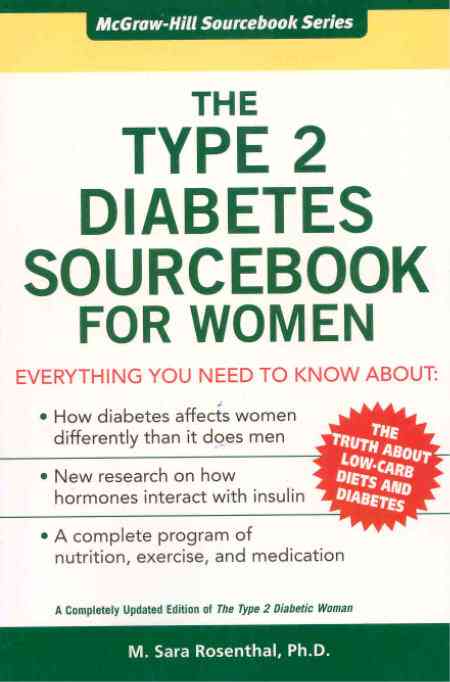
My British Book
This newsletter keeps you up-to-date with new articles, Web pages, and books that I have written about diabetes.
- I list and link most of these on my at Diabetes Directory and in the site’s menu.
- From time to time Diabetes Update may also include links to other Web pages of special interest.
My Recent Contributions:
- Perhaps of special interest to my readers in the U.K is that the new British edition of my first book will be in bookstores there on July 7. It will retail for £8.99. The book is What Makes My Blood Gluose Levels Go Up and Down? I wrote it with Dr. Jennie Brand-Miller and Kaye Foster-Powell.
The British publisher is Vermillion, an imprint of Ebury Publishing of the Random House Group. They changed the title a bit by adding the word “Levels.” The book came out first in the U.S. in 2003, published by Marlowe & Company, an imprint of Avalon Publishing Group. Then, last year Hodder Headline Group published the Australian edition.
I reviewed the first edition (as objectively as I could) in the September 2003 issue of Diabetes Update.
So far, I have only noticed one big change in this edition. It lists “David Mendosa” as one of the authors. The two previous editions carried my former name, “Rick Mendosa.”
- Meters in the 21st Century
We have come a long way in the 37 years since Tom Clemens invented the first blood glucose meter. But we aren’t there yet. A new era of continuous and noninvasive sensors is coming. Eventually, we will have the artificial pancreas that has been on the horizon for years.I wrote this feature article about past and future meters for the July issue of Diabetes Health magazine. My column is also online at http://www.mendosa.com/21st_century.htm.
Updates:
Levemir
Like peace, progress comes dropping slow. It was seven years ago that I first wrote about a wonderful insulin that Novo Nordisk was developing. And now the FDA has finally approved it. Like Lantus, the action of the Novo Nordisk insulin called Levemir lasts for up to 24 hours. But unlike any other insulin — or for that matter any other diabetes drug besides Metformin — in clinical trials Levemir did not cause weight gain.No weight gain is big news. The weight gain that accompanies any of the other insulins is counterproductive to excellent treatment of diabetes.
It was in November 1998 that I first wrote about Levemir in an article about Insulin Analogs for Diabetes Wellness Letter. And then again in November 2003 I wrote about it at Insulin Detemir, its generic name.
Previously 37 countries, including the European Union member states, had approved Levemir. Novo Nordisk hopes to make Levemir available in the U.S. sometime this year.
At this time, the Novo Nordisk website doesn’t have any information about Levemir for those of us who are only people with diabetes. But if you “solemnly declare” that you are a healthcare professional, you can read more on their Levemir page.
- GI or GL?
The glycemic index has great scientific credibility. I have written a lot about it, including my introductory page at http://www.mendosa.com/gi.htm. But the related concept of the glycemic load is being tarnished by association with low carb diets. The scientific community will need a lot more evidence before low carb diets are given the thumbs up.Professor Jennie Brand-Miller is clarifying these issues in the July issue of Diabetes Care. Dr. Brand-Miller of the University of Sydney is the world’s leading glycemic index expert and has authorized me to paraphrase her article.
Dana Carpender, a low-carb cookbook author, in The Birmingham News recommends that we “keep glycemic index low for health.” So far so good. But she also maintains, “The glycemic load (GL) is a much more meaningful way of assessing the impact of carbs on one’s body” than the glycemic index. It isn’t.
Low glycemic index and low glycemic load produce different clinical outcomes. The trouble with the glycemic load taken in isolation is that it doesn’t tell us whether the food has slow carbs or low carbs.
The glycemic index compares equal quantities of available carbohydrate in foods. The glycemic load is the product of a food’s glycemic index and its available carbohydrate content. That means the GL provides a summary measure of the relative glycemic impact of a standard serving of the food.
Further, this means that a food that is either low GI and high carb or high GI and low carb can have the same GL. That’s the problem, and we have scientific evidence that these two approaches have a very different metabolic effect. Further, the differences include insulin sensitivity, triglyceride concentrations, free fatty acid levels, and satiety.
Better than trying to follow a low GL diet is to use the GI to compare foods of similar composition within food groups. When we choose lower GI foods within food groups, we are automatically choosing those with a lower GL.
- The Dawn Phenomenom
Karen LaVine, a subscriber and Certified Diabetes Educator, reminds me that John Walsh recommends a green apple at bedtime to help control the high morning blood glucose known as the Dawn Phenomenom. Karen was responding to my article on ExtendBars and the Dawn Phenomenon.I had found that at least for me eating an ExtendBar at bedtime didn’t help me reduce my high morning readings. I really couldn’t see how eating a green apple at bedtime — a Granny Smith — would be any better, but I tried it anyway.
In my preliminary trials it works. If I continue to get such good results and if the rest of you can confirm them in your own tests, I will add an update to the ExtendBar article.
John Walsh and his wife Ruth Roberts run the outstanding Diabetes Mall website and have written several books together. Their apple-at-bedtime tip is in Stop the Rollercoaster: How to Take Charge of Your Blood Sugars in Diabetes, page 17. But Ruth reminds me that Stop the Rollercoaster is out of print and that they have the same tip in a more current book, Using Insulin, published in 2003.
They point out that the morning reading is the most important one of the day. A typical complaint, they say, is “If I wake up high, my whole day is shot!”
- Accept Your Size
Weight and type 2 diabetes are somehow connected. It’s not that being overweight causes diabetes. That couldn’t be the relationship because, for example, more than 60 percent of Americans are overweight compared with the 6 percent of us who have diabetes.Still, more than 80 percent of people with diabetes are overweight. So the connection may well be that diabetes and being overweight have the same cause. Several years ago I wrote about this tantalizing relationship at “The Insulin Problem.”
All the experts tell us that if we lose weight we will control our diabetes better. “Just take off 10 percent of your body weight,” is that standard advice. It’s probably true and certainly damn near impossible.
Nobody doubts the importance of losing weight. The only question is how. Dieting just doesn’t work.
Maybe we should forget about dieting. A small but significant study reported in the June issue of the Journal of the American Dietetic Association indicates that this might be a good idea.
A randomized clinical trial of 78 middle-aged women who were “chronic dieters” divided them into two:
- A diet group, and
- A “health at every size” group emphasizing five aspects:
- body acceptance
- eating behavior
- nutrition
- activity
- social support
Those in the diet group learned to limit the amount of food they ate, keep food diaries, regularly weigh themselves, and exercise. The other group focused on accepting their body, understanding their internal hunger cues, paying attention to their emotions about food, and increasing their physical activity. They ate what they wanted to and didn’t weigh themselves.
Those women in the “health at every size” group didn’t lose any weight during the six months of the trial with a two-year followup. The women in the diet group did lose weight at first, but gained it back, and after two years were dead even with where they started. Significantly, 41 percent of the dieters dropped out of the program, but only 8 percent of the nondieters quit.
The biggest difference was that the nondieters felt a lot better about their bodies. They also were much less depressed.
This study excluded people with diabetes and several other groups. But my guess is that it is relevant to us too. Accepting yourself as you are is one of the ancient keys to happiness.
“There is an extraordinary amount of scientific research that documents that dieting is not an effective health or weight-loss strategy,” the lead author, Dr. Linda Bacon, told Nicholas Bakalar of The New York Times.
The study, “Size Acceptance and Intuitive Eating Improve Health for Obese, Female Chronic Dieters,” is online at http://www.adajournal.org/scripts/om.dll/serve?action=searchDB&searchDBfor=art&artType=full&id=as0002822305003226.
Book Reviews:
This month I outsourced the book reviews. But not to the usual suspects, India or Taiwan, but instead to experts and friends in Florida, here in Boulder, Colorado, and Vermont.
- What would you do if you received a book for review that a pilot who has diabetes wrote? How about asking another author and pilot with diabetes? The book under review is Dare to Dream: Flying Solo With Diabetes and the reviewer is my friend Derek Paice. I wrote about him in 2001 as one of the people who is dominating diabetes.
His website DAPaice.com shows what a wonderfully versatile man Derek is and just how relevant is background is for reviewing Dare to Dream. His eBook, Diabetes and Diet: A Type 2 Patient's Successful Efforts at Control is online at his site (and also on my site at Diabetes and Diet). There you can also find his newest eBook, Effects of Aging on BG Control and Predictions of A1c. An engineer, his professional books include Power Electronic Converter Harmonics and Clean Power Electronic Converters.
Like the author of the book he reviews, Derek is also an ex-RAF pilot and wrote about those experiences in yet another book, Birds, Fools, and Angels. Derek often signs himself “Type 2 since 1990. Good control, primarily by diet, but with Ultralente to combat increased IR caused by prednisone … 75 mg of Plavix and 325 mg of aspirin for heart issues.” He is also a polio survivor and just days before writing the review below was hospitalized with 99 percent blockage in one of his heart’s major arteries. His quick recovery is testimony to his excellent condition.
Dare to Dream: Flying Solo With Diabetes
Reviewed by Derek Paice“Dare to Dream: Flying Solo With Diabetes” is an exciting, well-written, motivational story. Enthusiasm and the determination to succeed leaps out from almost every page.
Flying Solo with Diabetes
Anyone interested in aviation will enjoy the detailed description of numerous airplane adventures. My own flying experiences made those scenes especially fascinating. And I was pleased to learn that in the USA a pilot can fly solo provided blood glucose levels are within the limits defined by the FAA.
The author’s resolve to lead a life unhampered by the demands of type 1 diabetes shows how determination can overcome disadvantage. In many of the underdeveloped countries, and to a lesser extent the developed countries, the author found the common misconception that those with diabetes are limited.
By flying his own plane around the world in 159 days, Douglas Cairns dramatically exposes the fallacy of that misconception. His accomplishment is a great example of grasping an opportunity presented by adversity. Many readers may not need that reminder, but it’s always encouraging to read about another’s success. The author has not only helped himself; his book will surely help others.
With careful attention to the demands of one’s body, there is no need to fear diabetes. We can all dare to dream.
Albyne Press Limited at (303) 440-3474 in Boulder, Colorado, just published Dare to Dream for $16.95. The ISBN number is 0-9549929-0-3.
- The second book I received this month that I am not really qualified to review is about type 1 diabetes. I have type 2. But it happens that Douglas Cairns, the author of the book Derek Paice reviews above, has type 1 diabetes. Douglas agreed to review the new book by Ragnar Hanas on Type 1 Diabetes.
Type 1 Diabetes: A guide for Children, Adolescents, Young Adults … and Their Caregivers
Reviewed by Douglas CairnsType 1 Diabetes: A Guide for Children, Adolescents, Young Adults … and Their Caregivers by Ragnar Hanas, MD, PhD, is an extremely good read and reference book for anyone with or involved with caring for type 1 diabetes. It contains a tremendous wealth of “must know” information which is presented in an easy-to-read manner.
Type 1 Diabetes
Dr. Hanas outlines that this book should not be read cover to cover, but used as a reference book. Indeed, an excellent index allows Type 1 Diabetes to be used most effectively as a reference guide, while the very “readable” content may easily tempt the reader to progress from cover to cover after all. Very highly recommended.
Marlowe & Company published Type 1 Diabetes on July 15 for $24.95. The ISBN number is 1-56924-396-4.
-
The third book this month is for women with diabetes. It’s clear that I am not capable of reviewing this book either. But my friend Gretchen Becker is.
I consider myself fortunate to have known and worked with Gretchen since long before she became famous. When I first wrote about software for managing diabetes in 1999, she contributed 10 reviews about those programs, and they are still linked to that web page.
Like Derek Paice, in 2001 she was one of the people I profiled for the Diabetes Watch website as one of the people who are dominating their diabetes. You can read about her at dominating diabetes.
Gretchen has gone on to a much bigger career as one of the very best writers about diabetes. I have often said that her first book, The First Year — Type 2 Diabetes, is one of the two very best books about our condition. Her second book, Prediabetes — What You Need to Know to Keep Diabetes Away, is the best advice there is to prevent diabetes. Last year she wrote The Four Corners Diet — The Healthy Low-Car Way of Eating for a Lifetime with Dr. Jack Goldberg and Dr. Karen O'Mara.
Gretchen also owns and works a farm in Vermont. She is quite a writer and quite a woman.
Type 2 Diabetes for Women
Reviewed by Gretchen BeckerDiabetes is such an all-encompassing disease that most popular books on the disease don’t have room to discuss the problems specific to men or women or children or elderly people or specific ethnic groups. So when David asked me to review The Type 2 Diabetes Sourcebook for Women by M. Sara Rosenthal, I thought, “Oh, good. A whole book about women and diabetes. This should be great.”
For Women
Hence I was disappointed to find that although there are a couple of chapters specific to women’s needs (“Fertility, Pregnancy, and the Role of Estrogen” and “Type 2 Diabetes, Menopause, and Aging”), the bulk of the book is simply a basic primer on type 2 diabetes with a few sentences here and there mentioning women’s needs.
Rosenthal takes a standard ADA approach, telling you to learn the exchange system, eat low-fat food, eat 40 percent carbohydrates, and exercise (although the chapter on exercise has been removed). She also takes the ADA position that low-carb diets are dangerous because they stress the kidneys, and wants you to eat “potato, rice, pasta, or bread” for a “balanced” meal. She does, however, support the glycemic index, which the ADA has yet to do.
This book is a revised version of The Type 2 Diabetic Woman, with some chapters added and others removed, and I felt that no editor had gone through the revision closely to make sure it all hung together. Hence the text contains some contradictions. For example, on one page she says Humalog and NovoLog are short-acting insulins (like Regular), on the next she says they’re rapid-acting insulins (the correct category). Several pages earlier she said they were “immediate-acting,” which a reader might confuse with intermediate acting (like NPH). She also says they both peak in 3.5 to 4.5 hours (they peak at about an hour). I would not use this book as a guide to insulin use.
There are also some important omissions: For example, she doesn’t mention the drug Zetia for cholesterol control, and it has been on the market for several years.
The book would have benefited from a review by a chemist. She says table sugar consists of sucrose and glucose (it’s just sucrose) and dextrose and maltose break down into fructose and glucose (dextrose is another name for glucose, and maltose contains only glucose). And she repeats the old idea — which glycemic index research disproved many years ago — that sugar raises blood glucose faster than starch.
I’m probably overly picky when I read diabetes books. Rosenthal does support some good things such as frequent testing, especially for the newly diagnosed. And she says some diabetes experts now say that insulin resistance causes obesity, instead of the other way around. This is what patients have been saying for years, but no one listened.
If you really want the woman-specific information in the chapters I mentioned earlier and can deal with some inconsistencies and inexact science, you might enjoy this book. I hope the next edition will really focus on women’s problems and not try to cover so many bases. Does a person who has just been diagnosed with diabetes really need to know how to select a prosthetic limb?
McGraw-Hill just published The Type 2 Diabetes Sourcebook for Women for $17.95. The ISBN number is 0-0714492-9-9.
Announcements:
- HTML Format
I send out Diabetes Update e-mail in HTML format, which all Web browsers and most modern e-mail programs can display. HTML has live links to all the sites named in the text so that with a simple click of a mouse you can connect to the site you have just been reading about. - My Guarantee
This newsletter:- Is and will remain free.
- Nor will I ever sell, rent, or trade your e-mail address to anyone.
- I will link sources of information.
- I will disclose any conflict of interest.
- If and when I learn of any errors of fact, I will correct them.
Archives:
I now send out Diabetes Update once a month. Previous issues are online:
- Diabetes Update Number 1: Diabetes Genes of December 10, 2000
- Diabetes Update Number 2: DiabetesWATCH of December 18, 2000
- Diabetes Update Number 3: Starlix of January 3, 2001
- Diabetes Update Number 4: Native Seeds/SEARCH, Tepary Beans of January 17, 2001
- Diabetes Update Number 5: Insulin Makes You Fat of January 31, 2001
- Diabetes Update Number 6: Available and Unavailable Carbohydrates of February 15, 2001
- Diabetes Update Number 7: Dates of March 1, 2001
- Diabetes Update Number 8: Quackwatch of March 15, 2001
- Diabetes Update Number 9: The Cost of Insulin of March 30, 2001
- Diabetes Update Number 10: Sof-Tact Meter of April 2, 2001
- Diabetes Update Number 11: iControlDiabetes of April 16, 2001
- Diabetes Update Number 12: Cinnamon, Tagatose of May 2, 2001
- Diabetes Update Number 13: Glycemic Index of May 15, 2001
- Diabetes Update Number 14: Eat Your Carrots! of May 31, 2001
- Diabetes Update Number 15: Glycemic Load of June 21, 2001
- Diabetes Update Number 16: Homocysteine of July 2, 2001
- Diabetes Update Number 17: Chana Dal Tips of July 15, 2001
- Diabetes Update Number 18: Lag Time in AlternativeLand of August 2, 2001
- Diabetes Update Number 19: Fiber of August 15, 2001
- Diabetes Update Number 20: How Diabetes Works of August 30, 2001
- Diabetes Update Number 21: Insulin Resistance of September 14, 2001
- Diabetes Update Number 22: Trans Fats, Honey, CU of October 1, 2001
- Diabetes Update Number 23: Pedometer Power of October 15, 2001
- Diabetes Update Number 24: Is Glycerin a Carbohydrate? of October 31, 2001
- Diabetes Update Number 25: Kill the Meter to Save It of November 15, 2001
- Diabetes Update Number 26: Protein, Fat, and the GI of December 1, 2001
- Diabetes Update Number 27: Insulin Index of December 14, 2001
- Diabetes Update Number 28: Fructose of January 4, 2002
- Diabetes Update Number 29: Aspirin of January 14, 2002
- Diabetes Update Number 30: Stevia of January 31, 2002
- Diabetes Update Number 31: Gretchen Becker’s Book of February 19, 2002
- Diabetes Update Number 32: The UKPDS of March 4, 2002
- Diabetes Update Number 33: Financial Aid of March 18, 2002
- Diabetes Update Number 34: Pre-Diabetes of April 1, 2002
- Diabetes Update Number 35: More Glycemic Indexes of April 15, 2002
- Diabetes Update Number 36: Gila Monsters of April 30, 2002
- Diabetes Update Number 37: Is INGAP a Cure? of May 15, 2002
- Diabetes Update Number 38: Native American Diabetes of June 3, 2002
- Diabetes Update Number 39: FDA Diabetes of June 19, 2002
- Diabetes Update Number 40: Diabetes Support Groups of July 1, 2002
- Diabetes Update Number 41: New GI and GL Table of July 15, 2002
- Diabetes Update Number 42: Diabetes Sight of August 1, 2002
- Diabetes Update Number 43: DrugDigest of August 18, 2002
- Diabetes Update Number 44: Hanuman Garden of September 3, 2002
- Diabetes Update Number 45: Guidelines of September 16, 2002
- Diabetes Update Number 46: Trans Fat of October 4, 2002
- Diabetes Update Number 47: Nutrition.Gov of October 16, 2002
- Diabetes Update Number 48: Our Hearts of October 31, 2002
- Diabetes Update Number 49: Our Kidneys of November 15, 2002
- Diabetes Update Number 50: A1C<7 of December 2, 2002
- Diabetes Update Number 51: Diabetes Searches with Google of December 16, 2002
- Diabetes Update Number 52: e-Patients of January 2, 2003
- Diabetes Update Number 53: Email News of January 16, 2003
- Diabetes Update Number 54: Third Generation Meters of January 31, 2003
- Diabetes Update Number 55: Hypoglycemic Supplies of February 14, 2003
- Diabetes Update Number 56: Food Police of March 1, 2003
- Diabetes Update Number 57: Vitamins of April 1, 2003
- Diabetes Update Number 58: Lancets of May 1, 2003
- Diabetes Update Number 59: Accurate Meters of June 1, 2003
- Diabetes Update Number 60: Chromium of July 1, 2003
- Diabetes Update Number 61: Traveling of August 1, 2003
- Diabetes Update Number 62: My Book of September 1, 2003
- Diabetes Update Number 63: Hot Tubs of October 1, 2003
- Diabetes Update Number 64: Home A1C Testing of November 1, 2003
- Diabetes Update Number 65: Detemir of December 1, 2003
- Diabetes Update Number 66: Erectile Dysfunction of January 1, 2004
- Diabetes Update Number 67: Acidic Foods of February 1, 2004
- Diabetes Update Number 68: Net Carbs of March 1, 2004
- Diabetes Update Number 69: Glycemic Index of April 1, 2004
- Diabetes Update Number 70: Dreamfields Pasta of May 1, 2004
- Diabetes Update Number 71: Cholesterol of June 1, 2004
- Diabetes Update Number 72: Meter News of July 1, 2004
- Diabetes Update Number 73: Pill Splitting of August 1, 2004
- Diabetes Update Number 74: GlucoMON of September 1, 2004
- Diabetes Update Number 75: Coding of October 1, 2004
- Diabetes Update Number 76: Sleep Apnea of November 1, 2004
- Diabetes Update Number 77: Keynote Address of December 1, 2004
- Diabetes Update Number 78: Mangosteen of January 1, 2005
- Diabetes Update Number 79: Noninvasive Dream of February 1, 2005
- Diabetes Update Number 80: Pelikan Sun of March 1, 2005
- Diabetes Update Number 81: Medtronic Monitors of April 1, 2005
- Diabetes Update Number 82: ExtendBars of May 1, 2005
- Diabetes Update Number 83: GlycoMark of June 1, 2005



